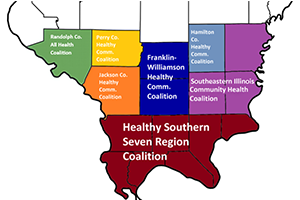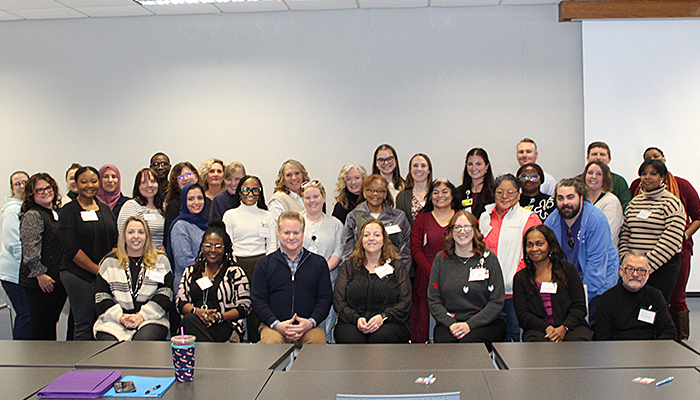Healthy Southern Illinois Delta Network
- Need: To improve people's health in a rural 16-county region in Illinois.
- Intervention: A coalition of local health departments and healthcare facilities coordinates regional efforts, which are implemented locally by health community coalitions.
- Results: HSIDN has created toolkits, developed resource guides, and provided wellness trainings, among other initiatives.
Description
Healthy Southern Illinois Delta Network (HSIDN), created in 2008, brings together health centers, hospitals, local health departments, and other organizations in a rural 16-county region. A steering committee of 10 organizations coordinates regional efforts, and 7 health community coalitions (made of over 500 members from community-based organizations and from the community) implement these efforts locally.

HSIDN organizations have received funding from the Illinois Department of Public Health, Centers for Disease Control and Prevention (CDC), Delta Regional Authority, Plan4Health, and the United States Department of Agriculture (USDA).
Services offered
HSIDN goals include:
- Improve substance use prevention and access to mental health services
- Promote healthy diets and body weights
- Improve cardiovascular health through prevention, screening, and treatment
Results
HSIDN coalitions and action teams:
- Created toolkits for smoke-free programming that coalition members can share with schools, worksites, housing, and others
- Developed and updated resource guides for diabetes and mental health services
- Introduced schools to a coordinated approach for school health and helped 29 schools adopt or strengthen wellness policies
- Made fact sheets about cancer disparities and distributed them to local health departments
- Provided regional trainings about built environment, worksite wellness, school health, and health impact assessment
- Provided wellness training and support at over 32 worksites affecting over 11,000 employees
- Facilitated 132 free Chronic Disease Self-Management Programs and Diabetes Self-Management Education and Support programs between March 2015 and October 2025 for people with diabetes and other chronic health conditions and their caregivers
- Created Camp BETA, a free overnight camp for children with type 1 diabetes. Since 2017, 130 children ages 10-17 have been served.
Challenges
Staff turnover at agencies and organizations plays a role in the work of the coalition. It is often a challenge to keep individuals engaged and to keep the action team and steering committees moving forward to improve the health of the community with so much staff turnover.
Replication
Success of the HSIDN is due to having a strong collaborative effort with healthcare systems, local health departments, as well as other community partners and community organizations working together to create policy, systems, and environmental changes. A regional plan, developed every five years, serves as the implementation framework for each local coalition and includes evidence-based strategies for each focus area. Implementation of programming related to the regional plan occurs through the efforts of the healthy community coalitions and various action teams. Healthcare systems and local health departments tie network efforts to their own community health needs assessments, which ensure sustainability.

Contact Information
Angie Bailey, MPH, MSEd, CHES, System Director for Community HealthSouthern Illinois Healthcare
angie.bailey@sih.net
Topics
Hospitals
· Networking and collaboration
· Wellness, health promotion, and disease prevention
States served
Illinois
Date added
September 30, 2022
Suggested citation: Rural Health Information Hub, 2026 . Healthy Southern Illinois Delta Network [online]. Rural Health Information Hub. Available at: https://www.ruralhealthinfo.org/project-examples/1103 [Accessed 18 January 2026]
Please contact the models and innovations contact directly for the most complete and current information about this program. Summaries of models and innovations are provided by RHIhub for your convenience. The programs described are not endorsed by RHIhub or by the Federal Office of Rural Health Policy. Each rural community should consider whether a particular project or approach is a good match for their community’s needs and capacity. While it is sometimes possible to adapt program components to match your resources, keep in mind that changes to the program design may impact results.
